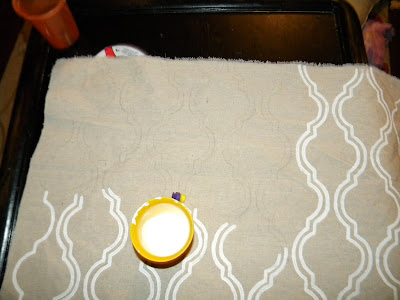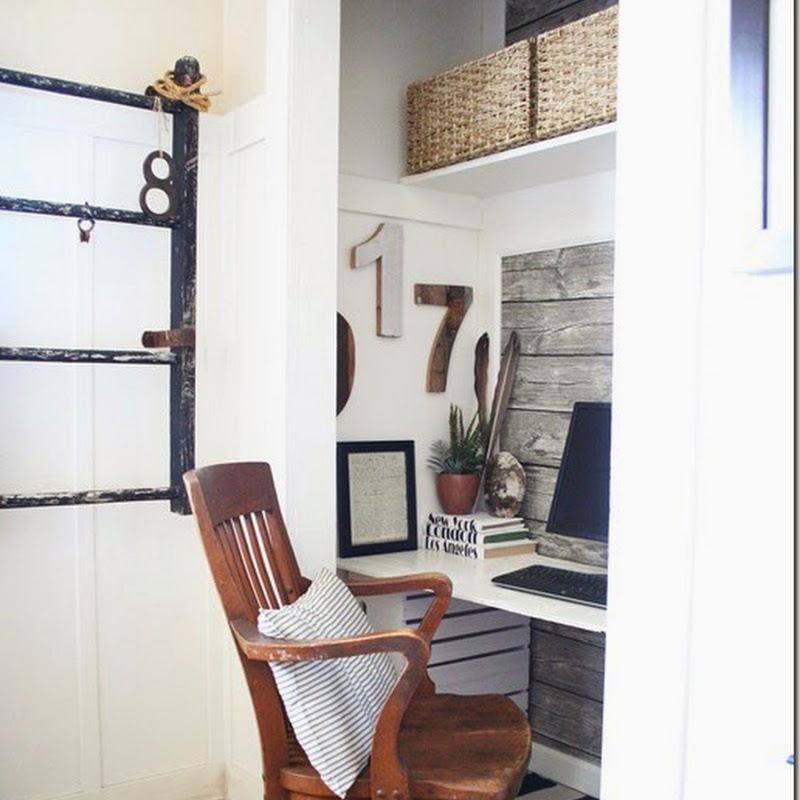*Disclaimer* My husband wrote this posting so if you don't speak engineer fluently, try printing this off and taking it to the local University. Or just look at the pictures like I always do.
 The Door
The DoorYou need to ensure that all lumber is as straight as possible when selecting it. Make sure all edges are clean before gluing them.

Take three of the 8’ 1X6 boards and lay them side by side on a flat surface. A large table or other elevated surface works best. Apply wood glue to the inside of the first two boards, ensure the ends are flush and then glue them together. Put wood clamps in at least three places on the boards and tighten them down until there is no visible gap between the boards (Note: Do not put the wood clams directly on the boards. Place small pieces of scrap between the jaws of the clamp and the boards). Do not over tighten or the boards will warp, you want to make sure they lay flat on the table or work surface.
Repeat this process with the other three 8’ 1X6 boards. Allow the boards to sit for a minimum of 3 hours. Overnight is better. Use a large square and a skill saw to trim the sections to the desired length based on the height of the doorway you are filling. If you are filling a standard doorway with existing trim measure from the bottom of the door to the top of the trim (make sure there will be a ¾” - 1” gap below the door when you are done) and cut the door to match.

You should now have two different sections of three 1X6s glued together. When gluing these two larger sections together you must be careful not to allow them to bow up in the middle. Glue between the two sections and clamp them like before, leaving at least 10” of board exposed at the top and bottom.

Measure the exact width of the combined 1X6s (you should come up with something close to 33”) and trim the 1X10 to fit across the top and bottom. Use a square on all of your cuts. Immediately glue the 1X10 across the top and bottom of the 1X6s and use C-Clamps to hold them in place. This will help hold your door flat, preventing bowing. Ensure that the 1X10 remains flush with the top and bottom edges of the door.
Allow all boards to dry. Remove all clamps and sand away excess glue. Ensure the surface is clean and smooth.
Measure 1X4 and cut the 1X4. The best way to do this is to put the board in place across the door use the square to mark it before trimming it. Glue the 1X4, put it in place and then nail it down with the finish nail gun. Nail the 1X10 at the top and bottom. Put at least two nails through the 1X10 and into each 1X6.Sand the entire door.
Your door is finished!
The Track
Use the chop saw to cut a piece of metal strap 51 ½” long. Place the last 1” securely in the vice. Use a square to make sure the strap is squared up in the vice. Carefully bend the strap using the sledge hammer to keep the radius of the bend tight. The tab you have bent into the strap should be displaced 90 degrees. Repeat on the other end of the strap.
The unbent portion of the rail should be 49 ½” long.

Drill 4 holes through the strap using the drill press. The outside holes should be 4” from the ends and the inside holes should be approx. 18” from each end. Holes should be large enough to allow ¼” bolts to pass through them.
Cut the six foot long 1X6 down to 66” (twice the width of the door). Measure 8 ¼” in from the end of the 1X6 and mark using the square. Measure ¼” from the long edge of the board and mark in at three places. Hold the strap firmly along the lines scribed on the board and use a hand drill and the same drill bit used before and begin holes into the board using the strap as a template. Once you have the holes started in the board, put the bit back in the drill press and drill the holes all the way through the board. Using the drill press will keep the holes straight.

Put carriage bolts through each of the new holes. Place a washer on the thread side of each bolt and then tighten down a nut over each of them. Place another nut over the first and tighten it until it is snug. Put the strap over the bolt and then place a third nut on the outside of the plate and tighten it down. The first two nuts act as spacers for the wheels to slide down.
You are done with the Track!
The Hard PartYou are almost done! This last step is the most difficult. If you happen to have a finger break (a tool used to bend sheet metal) then this part is a cinch. If you don’t then at the very least you will need a hefty vice, a good 2lb sledge and some ingenuity. Even with instruction you are going to have to think your way through this. The end result will look like this….

Cut two 16” pieces of strap.

Bend a 1 ½” Flange into the strap.
Insert a strong steel spacer into the vice with the strap. The spacer should be approximately the same width as the pulley wheel. Use the hammer and push down on the remaining strap to bend it as much as possible.

Open the jaws of the vice and put the strap between them then tighten the vice. This may require repositioning the piece several times. The piece should look like the image to the right when this step is done.
Mark the strap 2” from the top and then bend it 45 degrees.

Turn the piece over, reinsert it into the vice and bend it at 45 degrees a second time. There should be 2 1/8” OUTSIDE TO OUTSIDE when this is done. This measurement is based on a ¾” pulley wheel. If your pulley wheel is not ¾” wide then adjust the measurement such that the center of the wheel will end up directly above the 2X6 section of the door. This will be a space of 1 ¼” from the outside face of the part of the strap that will bolt to the door and the center of the pulley….
Repeat for the second strap.
Drill holes in each strap for the pulley wheels. Center it in the C-Channel you have created in the strap. Drill two holes in the face of the straps and then through the door. Take special care to ensure that the center of both pulleys are the same distance from the top of the door and that the door will swing with a ½” – 1” gap at the floor. Bolt the straps to the door. Bolt on the pulley wheels and you are ready to hang your door!
































































